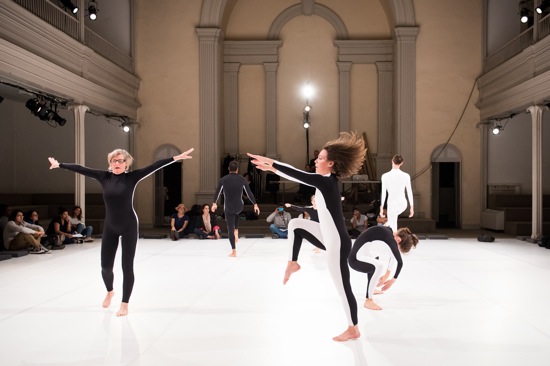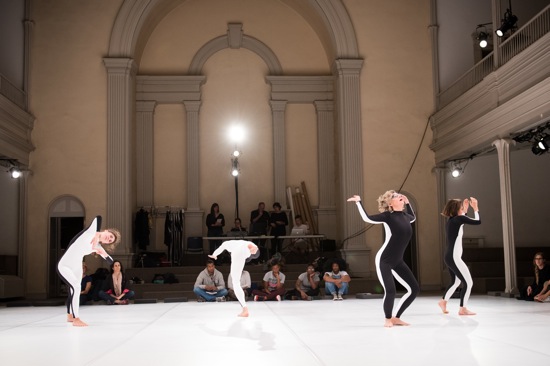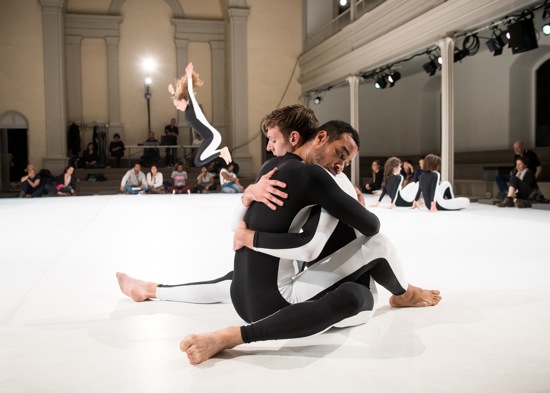Danspace St. Mark’s presents Moriah Evans’s “Social Dance 9-12: Encounter.”

Moriah Evans’s Social Dance 9-12: Encounter. (L to R): Irene Hultman, Rashaun Mitchell, Lydia Okrent, Lizzie Feidelson, and Benny Olk. Photo: Ian Douglas
Leaving St. Mark’s Church after seeing Danspace Project’s presentation of Moriah Evans’s Social Dance 9-12: Encounter, I had a surprising thought about the experience: “This is so non-interesting that it’s interesting.” Then I spent the bus trip home wondering what I meant by that.
Note that I didn’t think the work was uninteresting. Clearly Evans, composer David Watson, lighting designer Kathy Kaufmann, co-visual designer Strauss Bourque-La France, “dramaturgical advisor” Caroline Spellenberg, and Evans’s six very diverse performers have produced something that gets your attention and provokes thoughts about the process by which it was made. What I mean (or think I mean) has to do with how you experience its elements, especially in the work’s first part.
The way the audience members are guided in sets us up for novelty. We don’t enter through the church’s front doors; instead we walk around to the rear entrance, climb a flight of chairs, enter the sanctuary via doors that open onto the balcony, descend another flight of stairs, and find seats—mostly on the floor (a few elder citizens sit on the carpeted risers). The dance can be seen from four sides; that includes the altar platform where Watson mans laptops and other electronic equipment and Jeanann Dara plays violin or viola. While we wait, we can listen to the noisy overhead footsteps of the next arriving spectators.
The dancers are already in place, scattered around the border of the performance area and sitting very close to the spectators. At some point near the beginning, Rashaun Mitchell is close to my corner. He’s wearing a half-black, half-white unitard, as are his fellow performers. And yes, he’s pretty interesting; his eyes are sliding around in their sockets, angling for a view, while his head is moving in a contrary direction so that he’s seldom facing head-on what he’s glancing at. I can see Iréne Hultman’s face too, but she’s wearing eyeglasses, so her glances are less obvious.
Early on, Mitchell opens his mouth wide, presaging a variation on this opening sequence. Soon, the dancers make extreme facial experiments—not ones indicating joy or sorrow, but, say, wrenching an open mouth sideways, squinting one eye, raising an eyebrow and wrinkling the nose (I’m practicing as I write this). Occasionally one or more dancers will rise, walk to another side of the space, sit down, and continue her/his oblique fragmentations of what we usually perceive as a smooth, composed face. The music begins with a low sound that, in time, works its way into surging. A soft tweeting and whistling enters.
Soon we get it. I can relish the fact that when Lydia Okrent is in my sightlines, her whole body twists and slumps and straightens up in order to power her facial acrobatics. Lizzie Feidelson, sitting beside her approaches the task with more restraint.
I can view one, maybe two others at a time, but the rest have their backs to me, and what I mostly see are the spectators’ faces (rarely do they twitch in spontaneous sympathy, but some smile). I know what’s going on; I can loosely predict the departure of one grimacer and the arrival of another, and I surmise what the other performers are doing. After a while, I find myself thinking, okay. Now what?

L to R: Lizzie Feidelson, Benny Olk, Irene Hultman, and Lydia Okrent in Moriah Evans’s new work. Photo: Ian Douglas
Evans wrote of her previous Social Dance 1-8: Index that it “investigates a system of patterns that propel bodies through space and affective states” and “considers how we dance together, and build social relationships through choreographic pathways that are known and practiced in dancing and witnessing.” Is Social Dance 9-12: Encounter the high-school version of this?
She has also written, “The image must be a readymade reinvented or reclaimed to perform itself as choreographic in a series of planned situations.” This is a little more opaque, and I’m wondering if the facial-exertion idea has been retrieved and reinvented from Mitchell’s 2013 Interface.
So I’m thinking now that if theories and patterns and emotions and redesigned appropriations are what drove this work into existence, can we be expected to see all that in the finished work? Or is it enough that we sense structural and imagistic ghosts haunting what we actually see?
Anyway, I can begin to wonder about the several boom boxes that are occasionally carried to a new location and sometimes argue quietly with the music that is being produced onstage. I can consider the effect of the costumes. Feidelson, Okrent, and Mitchell wear unitards that are white in front and black in back. Hultman, Benny Olk and Maggie Cloud sport the reverse. Whatever the significance, the effect of such moves as a reclining dancer twisting his/her legs together in a novel way is to make you imagine that one of the legs doesn’t belong to the person doing the twisting.

Moriah Evans’s Social Dance 9-12: Encounter. Foreground: Rashaun Mitchell and Benny Olk. Jumping: Maggie Cloud. Seated (L to R): Lizzie Feidelson and Lydia Okrent. Photo: Ian Douglas
Surprises crop up. Mitchell is suddenly giddy—silly even—wobbling from side to side like a kid getting crazy, or tantrummy. I didn’t notice Cloud undoing her bun, so it’s doubly exciting to see her lashing her long, blonde hair violently forward and back while jumping over and over. As she does this, Feidelson and Okrent lounge close to one bank of spectators, and Mitchell and Oik sit embraced, as if time has stopped.
The pace picks up, both in the dancing and the aural landscape. There appears to be a string of movements that any one of the six can be doing at any time. Or any few of them. Hultman almost never stops moving strenuously, while Mitchell takes some time out to sit and exercise his face. You become familiar with some of the moves: the stiff bending forward to make a right angle between legs and torso; the balance with one leg raised high to the side, the hops, the leaps with shoulder wiggles, and a few more. Many of the steps look deliberately unrefined—gawky. Others are performed with precision. Although I don’t know what system is determining the choreography, I sense that a lot of planning went into it; these are all serious artists. But the systems and the sources for the movements are not visible. We are left with what we see and what we can imagine about what we see, if we’re determined to grasp what Evans wants to convince us of.
